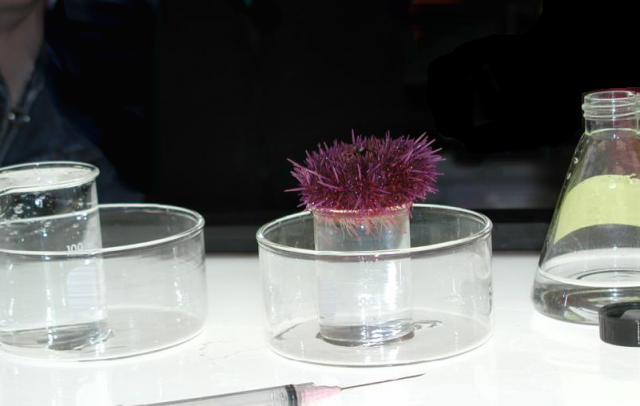Whole Effluent Toxicity Methods

- Method Guidance and Recommendations for WET Testing (2000)
Guidance and recommendations on the conduct of the approved WET test methods and interpretation of WET test results reported under the NPDES program
Acute Toxicity to Freshwater and Marine Organisms
The tests in the WET Acute Methods Manual (5th edition, 2002) consist of a control and a minimum of five effluent concentrations. The EPA recommends the use of ≥0.5 dilution factor and five effluent concentrations and a control. The test duration is typically 24, 48, or 96 hours. The test methods allow for permutations such as temperature, dilution water, frequency of the effluent renewal and more. The following methods listed in 40 CFR 136.3 are described in the manual.
| No. | Method Title (as listed in 40 CFR 136.3, Table I A) |
|---|---|
| Errata sheet (2016). Promulgated as part of the 2017 Methods Update Rule. | |
| Freshwater methods: | |
| 2000.0 | Fathead Minnow, Pimephales promela, and Bannerfin shiner, Cyprinella leedsi |
| 2002.0 | Daphnia, Ceriodaphnia dubia |
| 2019.0 | Rainbow trout, Oncorhynchus mykiss, and Brook trout, Salvelinus fontinalis |
| 2021.0 | Daphnia puplex and Daphnia magna |
| Marine/Estuarine methods: | |
| 2004.0 | Sheepshead minnow, Cyprinodon variegatus |
| 2006.0 | Silverside, Menidia beryllina, Menidia menidia, and Menidia peninsulae |
| 2007.0 | Mysid, Americamysis bahia (formerly Mysidopsis bahia) |
Chronic Toxicity to Freshwater Organisms
The tests in the WET Freshwater Chronic Methods Manual (4th edition, 2002) recommend the use of the ≥0.5 dilution factor and five effluent concentrations and a control for four to eight days. The test methods allow for permutations such as various dilution waters, daily or three effluent sample collections for daily test renewals, and more. The biological test endpoints include survival, growth, reproduction, or teratogenicity.
| No. | Method Title (as listed in 40 CFR 136.3, Table I A) |
|---|---|
| Errata sheet (2016). Promulgated as part of the 2017 Methods Update Rule. | |
| 1000.0 | Fathead minnow, Pimephales promelas, larval survival and growth |
| 1001.0 | Fathead minnow, Pimephales promelas, larval survival and teratogenicity |
| 1002.0 | Daphnia, Ceriodaphnia dubia, survival and reproduction |
| 1003.0 | Green alga, Selenastrum capricornutum, growth (species is now known as Raphidocelis subcapitata) |
Chronic Toxicity to Marine and Estuarine Organisms
The tests in the WET Marine Chronic Methods Manual (3rd edition, 2002) typically involve the exposure of test organisms to five effluent concentrations and a control for one hour to nine days. The test methods allow for permutations such as various dilution waters, daily or three effluent sample collections for daily test renewals, and more. In addition to survival, sub-lethal endpoints such as growth, fecundity, teratogenicity, or fertilization are measured. These methods listed in 40 CFR Part 136.3 apply to marine and estuarine organisms of the Atlantic Ocean and the Gulf of America.
| No. | Method Title (as listed in 40 CFR 136.3, Table I A) |
|---|---|
| Errata sheet (2016). Promulgated as part of the 2017 Methods Update Rule. | |
| 1004.0 | Sheepshead minnow, Cyprinodon variegatus, larval survival and growth |
| 1005.0 | Sheepshead minnow, Cyprinodon variegatus, embryo-larval survival and teratogenicity |
| 1006.0 | Inland silverside, Menidia beryllina, larval survival and growth |
| 1007.0 | Mysid, Americamysis (formerly Mysidopsis) bahia, survival, growth and fecundity |
| 1008.0 | Sea urchin, Arbacia punctulata, fertilization |
Note: While there are additional test procedures in the marine and estuarine test method manuals, two are not listed in 40 CFR 136.3, Table I A:
- Acute method for mysid shrimp, Holmesimysis costata, Acute Toxicity Test Method 2007.0 (Table 19). This species is specific to Pacific Coast waters and is not listed at Part 136 for nationwide use.
- Short-term test method to estimate chronic toxicity, the Red Macroalga, Champia parvula, Reproduction Test Method 1009.0 is not listed at Part 136 for nationwide use.
